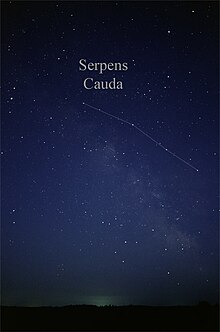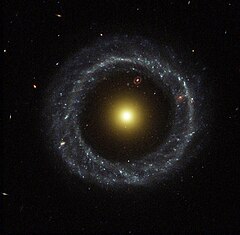Serpents
Serpens (the serpent) is one of the 88 modern constellations and was one of the 48 listed by Ptolemy. Among the modern constellations it is the only one divided into two parts:
- Serpens Caputwhich represents the head of the serpent, located west.
- Serpens Caudawhich represents the tail, east.
Between these two parts is the constellation of Ophiuchus, the bearer of the serpent. Since a single constellation is considered, the ordering according to the Bayer name takes into account both parts. On the head of the snake are located α, β, γ, δ, ε, ι, κ, λ, μ, π, ρ, σ, τ, χ and ω Serpentis. In the tail are located ζ, η, θ, ν, ξ and ο Serpentis.
Notable features
Only one Serpens star—α Serpentis—is brighter than magnitude 3, so the constellation is not easy to recognize. 74 light-years distant, α Serpentis is an orange giant of spectral type K2IIIbCN1, 15 times larger than the Sun, which is called Unuk or Unukalhai. Next in brightness is η Serpentis, an orange giant or subgiant whose diameter, calculated from its angular diameter (2.98 milliarcseconds), is nearly six times the diameter of the Sun. ξ Serpentis —fourth brightest star— is a white-yellow star, classified as a giant or subgiant of type A9IIIpSr: with a luminosity 31 times greater than that of the Sun. It is a Delta Scuti variable, and, in addition, a spectroscopic binary whose companion has a period of 2.29 days.
Serpens has several stars similar to the Sun. The closest, 38 light-years away, is λ Serpentis, a yellow dwarf of spectral type G0V although with twice the luminosity of the Sun. ψ Serpentis, 48 light-years away, is more similar to our Sun in terms of temperature and luminosity (it is of type G2.5V), although it has a stellar companion at a distance of 61 AU or greater. 39 Serpentis is another solar analog of equal luminosity to the Sun, although it may be younger than our star. Much closer to the Sun is dim HD 143436, 142 light-years away, a possible solar twin of the same mass, luminosity, and size as the Sun; however, its lithium content is six times more abundant than in our star, although the Sun seems to be depleted in this element in relation to other stars in its environment.
There are several stars in the constellation in which extrasolar planets have been discovered. ω Serpentis, the brightest among them, is an orange giant that has a planet with an orbital period of 277 days. HD 168746 —called Alasia according to the IAU— is a yellow dwarf with a planet whose minimum mass is 0.23 times the mass of Jupiter; located very close to the star —barely 0.065 AU—, it completes an orbit every 6.4 days. The equilibrium surface temperature of the planet at this distance is 900 K. The NN Serpentis system is also very interesting: it consists of a very hot white dwarf —57,000 K— and a red dwarf very close to each other, the separation between them being less than the solar radius (0.93 solar radii). The orbital period of this close binary is only 3.13 hours. Two planets have been discovered around it with a separation of 3.4 and 5.4 au respectively. Another notable object is PSR J1719-1438, a pulsar where a possible planet in orbit around it has been detected. The planet appears to have a density of at least 23 g/cm³, such that it can be considered a non-luminous, carbon-oxygen white dwarf with very low mass and density.
The deep sky objects in Serpens Caput include the globular cluster M5, located 23,500 light-years away. This cluster has been used to test the magnetic moment of neutrinos, which could shed light on some hypothetical particles such as the axion. Another globular cluster, located just to the south of M5, is called Palomar 5. Many stars in this cluster are being pulled out of it by the gravitational action of the Milky Way, forming a tidal tail more than 30,000 light-years away.
In Serpens Cauda you can see the Eagle Nebula and its associated star cluster, M16, which lie 5,700 light-years from us in the direction of the galactic center. The well-known Hubble Space Telescope image—dubbed the "Pillars of Creation"—shows a broad star-forming region of this nebula. Another object of interest is the so-called Red Square Nebula, a planetary nebula around the star MWC 922. It has the shape of an almost perfect square with a dark band around the equatorial regions.
Seyfert's Sextet is a grouping of six galaxies, four of which interact gravitationally; the fifth galaxy is further away while the last "galaxy" is actually a separate part of one of the other galaxies. This cluster of galaxies is 190 million light-years away and approximately 100,000 light-years across, making it one of the densest known galaxy groupings.
More distant —approximately 600 million light years away— is the Hoag Object (PGC 54559), an atypical ring galaxy. It appears as an almost perfect ring of young blue stars surrounding a core of older yellow stars. The gap between the ring and the core may contain some star clusters too faint to be observed, although another ring galaxy probably further away can be seen through it. It is named after Art Hoag, who discovered this object in 1950.
Main Stars
- α Serpentis (Unukalhai or Unuk), the brightest constellation with magnitude 2,63, an orange giant star at 73 light years.
- β Serpentis (Chow), of magnitude 3.54, white star of the main sequence.
- γ Serpentis, yellow dwarf 36 light years from the solar system.
- δ Serpentis, binary star formed by two white-yellow subgiants.
- ε Serpentis, white star of the main sequence of magnitude 3,71 similar to Denébola (β Leonis).
- γ Serpentis, white-yellow subgrown of magnitude 4,62.
- η Serpentis, although it holds the name of Bayer Eta, is the second brightest star of constellation with magnitude 3.26. It's a giant or subgant orange star.
- θ Serpentis (Alya), star system formed by two separate white stars 22 seconds of arc that can be solved with a small telescope.
- κ Serpentis, red giant 348 light years away.
- λ Serpentis, a solar analog star located 38 light years from Earth.
- μ Serpentis, white star of the main sequence located at 156 light years.
- ? Serpentis, of magnitude 4,24, is also a white star.
- roga Serpentis, spectroscopic binary and Delta Scuti variable located at 105 light years.
- π Serpentis, white star surrounded by a dust disk.
- σ Serpentis, white star of magnitude 4,82.
- Δ Serpentis can refer to eight different stars; among them, τ4 Serpentis is a variable red giant, τ5 Serpentis is a star of the main sequence and τ7 Serpentis a star with metal lines.
- φ Serpentis, orange subgigant of magnitude 5.54.
- χ Serpentis, chemically peculiar star of magnitude 5.32.
- END Serpentis, binary star whose primary component is a yellow dwarf very similar to the Sun.
- 5 Serpentis, yellow giant and variable BY Draconis also known as MQ Serpentis.
- 10 Serpentis, white subgiant of magnitude 5.15.
- 39 Serpentis, yellow dwarf at 57 light years away.
- R Serpentis, variable star Look whose brightness fluctuates between magnitude 5,16 and 14,4 throughout a cycle of 356,4 days.
- AS Serpentis, ellipsing binary of magnitude 11,62.
- FR Serpentis, Ap star and variable Alfa2 Canum Venaticorum.
- MS Serpentis, binary star and variable BY Draconis.
- NN Serpentis, binary system composed of a hot white dwarf and a red dwarf; two planets are known in orbit around this system.
- OT Serpentis, red dwarf and shining star 37 light years away.
- QY Serpentis, red giant and semi-regular variable.
- MWC 297 (NZ Serpentis), Star Be, one of the largest stars in the solar system.
- HD 143436, solar twin of magnitude 8,04 distant 142 light years from Earth.
- HD 168443, yellow dwarf with a giant planet and a brown dwarf.
- HD 168746, yellow dwarf with a planet that uses only 6.4 days to complete its orbit.
- Gliese 701, distant red dwarf 25 light years.
- Gliese 710, red dwarf that within 1.4 million years will approach only 1 light year of the solar system.
- GJ 1224, red dwarf at 24.6 light years.
- PSR J1719-1438, orbited by a possible planet that could be composed of diamond.
Deep Sky Objects
- Glybular cluster M5, located very close to 5 Serpentis (MQ Serpentis). With an approximate age of 13 billion years, it is one of the oldest globular clusters associated with the Milky Way.
- NGC 6539, also a globular cluster that is 25 400 light years old.
- Palomar 5, another globular cluster. The gravitational action of the Milky Way is breaking down its structure.
- Eagle Nebula (M16), young emission nebula associated with the open cluster NGC 6611. The brightest star of the nebula has magnitude +8,24, being observable with good binoculars.
- Cuadrada Red Nebula (MWC 922), a remarkable bipolar nebula due to its square shape. It is one of the most symmetrical deep sky objects ever discovered.
- Westerhout 40 (W40), star formation region in the distant Milky Way approximately 440 paras. It is one of the closest regions where spectral stars O and B form. The ionizing radiation from the massive OB stars has created an HII region, which presents a morphology of "sand clock".
- SNR G016.7+00.1, rest of supernova that is located at a distance of 14,000 paras.
- Hoag object (PGC 54559), a distant anular galaxy whose appearance has fascinated both amateur astronomers and professionals since its discovery in 1950. There is no clear consensus on its origin.
- NGC 5962, a spiral galaxy of visual magnitude 11,3; it is the brightest galaxy in the cluster of Serpens galaxies.
- NGC 5970, also spiral galaxy, located at 90 million light years.
- NGC 6118, spiral galaxy to 83 million light years. It has loose spiral arms, lacking central bar as well as clearly defined spiral arms, as is the case of the Milky Way.
- Sexteto de Seyfert, group of galaxies about 190 million light years away. The group seems to contain six members, but one of the galaxies is a background object and another "galaxia" is not such, but a separate part of one of the remaining galaxies.
Mythology
Serpens is the snake that Ophiuchus, the serpent bearer, is clutching, and logically it is closely associated with him. Originally, Serpens and Ofiuco were considered as a single constellation, from which arose a myth associated with the founding of medicine. It is identified in Greek mythology with the serpent that reveals to Asclepius the secrets of medicine.
Contenido relacionado
Polar Star
Julio Garavito
(9766)Bradbury






